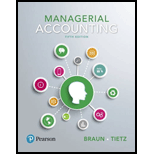
Managerial Accounting (5th Edition)
5th Edition
ISBN: 9780134128528
Author: Karen W. Braun, Wendy M. Tietz
Publisher: PEARSON
expand_more
expand_more
format_list_bulleted
Concept explainers
Textbook Question
Chapter 3, Problem 3.8SE
Continuation of S3-7: determine over- or under allocation (Learning Objectives 3 & 5)
Use your answers from S3-7 to determine the total overallocation or under allocation of manufacturing
- 1. Assume that the company used direct labor hours as the allocation base.
- 2. Assume that the company used the direct labor cost as the allocation base.
- 3. Assume that the company used machine hours as the allocation base.
- 4. Were there any situations in which
jobs were costed correctly? If not, when were they overcosted? When were they undercosted?
Expert Solution & Answer
Want to see the full answer?
Check out a sample textbook solution
Students have asked these similar questions
Provide correct solution and accounting
Solve this question accounting
Solve this question and accounting question
Chapter 3 Solutions
Managerial Accounting (5th Edition)
Ch. 3 - (Learning Objective 1) For which of the following...Ch. 3 - (Learning Objective 2) Which of the following...Ch. 3 - (Learning Objective 2) Which of the following...Ch. 3 - (Learning Objective 3) The amount of manufacturing...Ch. 3 - (Learning Objective 4) Which of the following is...Ch. 3 - (Learning Objective 5) Which of the following is...Ch. 3 - (Learning Objective 5) Assuming the amount of...Ch. 3 - Prob. 8QCCh. 3 - Prob. 9QCCh. 3 - Prob. 10QC
Ch. 3 - Identify product costs, period costs, and product...Ch. 3 - Decide on product costing system (Learning...Ch. 3 - Determine the flow of costs between inventory...Ch. 3 - Understanding key document terms in a job cost...Ch. 3 - Compute a professional billing rate (Learning...Ch. 3 - Prob. 3.6SECh. 3 - Continuation of S3-6: compute total allocated...Ch. 3 - Continuation of S3-7: determine over- or under...Ch. 3 - Prob. 3.9SECh. 3 - Calculate job cost and billing at appliance repair...Ch. 3 - Calculating overallocated or underallocated...Ch. 3 - Prob. 3.12SECh. 3 - Record manufacturing labor costs (Learning...Ch. 3 - Prob. 3.14SECh. 3 - Prob. 3.15SECh. 3 - Understanding key terms (Learning Objectives 1, 2,...Ch. 3 - Identify type of costing system (Learning...Ch. 3 - Prob. 3.18AECh. 3 - Determine the cost of a job and use it for pricing...Ch. 3 - Compute a predetermined overhead rate and...Ch. 3 - Prob. 3.21AECh. 3 - Prob. 3.22AECh. 3 - Determine the cost of a job (Learning Objectives...Ch. 3 - Compare bid prices under two different allocation...Ch. 3 - Analyze manufacturing overhead (Learning...Ch. 3 - Record manufacturing overhead (Learning Objectives...Ch. 3 - Record journal entries (Learning Objectives 2, 3,...Ch. 3 - Analyze T-accounts (Learning Objectives 2, 3, 5, ...Ch. 3 - Job cost and bid price at a consulting firm...Ch. 3 - Record journal entries (Learning Objectives 2, 3,...Ch. 3 - Identify type of costing system (Learning...Ch. 3 - Understand the flow of costs in a job cost shop...Ch. 3 - Prob. 3.33BECh. 3 - Prob. 3.34BECh. 3 - Prob. 3.35BECh. 3 - Sustainability and job costing (Learning...Ch. 3 - Determine the cost of a job (Learning Objectives...Ch. 3 - Compare bid prices under two different allocation...Ch. 3 - Analyze manufacturing overhead (Learning...Ch. 3 - Record manufacturing overhead (Learning Objectives...Ch. 3 - Record journal entries (Learning Objectives 2, 3,...Ch. 3 - Analyze T-accounts (Learning Objectives 2, 3, 5, ...Ch. 3 - Prob. 3.43BECh. 3 - Record journal entries (Learning Objectives 2, 3,...Ch. 3 - Analyze Manufacturing Overhead (Learning...Ch. 3 - Use job costing at an advertising agency (Learning...Ch. 3 - Use job costing at a consulting firm (Learning...Ch. 3 - Prepare job cost record (Learning Objectives 2, 3,...Ch. 3 - Determine and record job costs (Learning...Ch. 3 - Determine flow of costs through accounts (Learning...Ch. 3 - Analyze Manufacturing Overhead (Learning...Ch. 3 - Use job costing at an advertising agency (Learning...Ch. 3 - Use job costing at a consulting firm (Learning...Ch. 3 - Prepare job cost record (Learning Objectives 2, 3,...Ch. 3 - Determine and record job costs (Learning...Ch. 3 - Determine flow of costs through accounts (Learning...Ch. 3 - Job costing or process costing for wedding...Ch. 3 - Discussion Questions 1. Why would it be...Ch. 3 - Unwrapped or How Its Made Go to www.YouTube.com...Ch. 3 - Ethics involved with choice of cost driver...Ch. 3 - Prob. 3.61ACTCh. 3 - Issues with cost of job (Learning Objectives 2, 3,...
Knowledge Booster
Learn more about
Need a deep-dive on the concept behind this application? Look no further. Learn more about this topic, accounting and related others by exploring similar questions and additional content below.Similar questions
- I want the correct answer with accounting questionarrow_forwardOriole Company sells product 2005WSC for $55 per unit and uses the LIFO method. The cost of one unit of 2005WSC is $52, and the replacement cost is $51. The estimated cost to dispose of a unit is $6, and the normal profit is 40% of selling price. At what amount per unit should product 2005WSC be reported, applying lower-of-cost-or-market?arrow_forwardNonearrow_forward
arrow_back_ios
SEE MORE QUESTIONS
arrow_forward_ios
Recommended textbooks for you
 Cornerstones of Cost Management (Cornerstones Ser...AccountingISBN:9781305970663Author:Don R. Hansen, Maryanne M. MowenPublisher:Cengage Learning
Cornerstones of Cost Management (Cornerstones Ser...AccountingISBN:9781305970663Author:Don R. Hansen, Maryanne M. MowenPublisher:Cengage Learning

Cornerstones of Cost Management (Cornerstones Ser...
Accounting
ISBN:9781305970663
Author:Don R. Hansen, Maryanne M. Mowen
Publisher:Cengage Learning
Cost Accounting - Definition, Purpose, Types, How it Works?; Author: WallStreetMojo;https://www.youtube.com/watch?v=AwrwUf8vYEY;License: Standard YouTube License, CC-BY